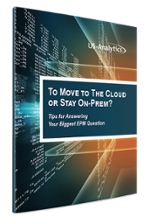It’s going to be a big year for analytics, especially now that Oracle has released its on-prem OAS product. While many front-end and back-end users are chomping at the bit to dig into it and get to know its functions and capabilities, you might be a little hesitant to embrace another product from the Oracle Analytics family, especially if you’re anticipating a shift to the cloud in the not-so-distant future.
We’ve got you covered. This article examines exactly what OAS encompasses and what its key features are. And for more information on the benefits and drawbacks of both on-prem and cloud solutions, check out our eBook “To Move to the Cloud or Stay On-Prem?” by clicking the button below or to the right.
 What is Oracle Analytics Server?
What is Oracle Analytics Server?
Oracle Analytics Server, or OAS, is the on-premises answer to Oracle Analytics Cloud (OAC). It’s the newest addition to Oracle’s product suite—but it’s not entirely new. OAS replaces OBIEE 12c as Oracle Analytics on-prem solution.
Don’t worry if you’re still dependent on OBIEE 12c—current and active OBIEE users are automatically licensed to use OAS, decreasing friction during the transition between the two products (It's automatically available for them to search on E-delivery by “Oracle Analytics Server"). The idea behind “auto-licensing” OBIEE customers to use OAS is that it gives users the power to make the shift to the cloud on their own terms, and it makes OAS a natural steppingstone on the path to using cloud analytics software. All the functionality of OBIEE 12c is integrated into OAS, making it a cinch for end-users to be comfortable with the new product.
Features of OAS
It’s not breaking news that OBIEE was getting an overhaul in the form of OAS; we’ve even reported on this in the past. But now that OAS is finally here, what is it capable of?
When Oracle developed OAS, they weren’t playing around. It’s packed with hard-hitting components that demonstrate how powerful an on-prem analytics solution can be. Oracle developed it to be comparable to OAC in terms of functionality, and they delivered. Now, let’s dive into the highlights of the key features of OAS.
Interactive dashboards
The OAS interactive analytics dashboards aggregate data from your software and programs and allow you to personalize your views of it, giving you a holistic perspective of your organization. You can use the dashboards to drill down deeper into the data as you see fit and filter it for easier visualization.
Ad hoc analysis and interactive reporting
Keep the same ad hoc and interactive reporting you are familiar with and have been using forever. Run the reports you need when you need them with ad hoc analysis, and then enjoy the resulting plain-language reports on complex topics with interactive reporting. OAS lets users have a logical view of metrics, hierarchies, and calculations in easy-to-digest terminology.
Mobile functionality
OAS is mobile, which is a huge deal in this on-the-go world we live in. And the mobile version isn’t OAS light, it’s a powerful full version that gives users the same functionality (in the form of an application) as if they were sitting at a desktop computer. This includes secure views of dashboards, analyses, reports, scorecards, maps, alerts, and more.
Analytics features
Oracle offers three tenets of analytics within their OAS product: Embedded, augmented, and collaborative. Each has a different purpose and solves a different problem for users.
Embedded analytics
Embedded analytics is exactly what it sounds like—analytics embedded in the context of another application. This functionality is extremely valuable to anyone who needs to get the right data in the right place at the right time (i.e., all organizations).
Augmented analytics
Natural Language processing (NLP), Machine Learning (ML), and Artificial Intelligence (AI) are what make the augmented analytics feature so powerful. Oracle’s goal in implementing augmented analytics is to reach “100% data literacy,” so the plain language shared with end-users by the OAS NLP system helps to reach that end.
Predictive analytics
The predictive analytics feature in OAS uses ML to recognize patterns in your data, thus allowing it to more accurately forecast results.
OAS also includes:
- Oracle Analytics: Publisher
- Oracle Analytics Server Enterprise Edition
- Oracle Analytics Administrator
- Oracle Analytics Interactive Dashboards
- Oracle Analytics Delivers
- Oracle Analytics Answers
High availability, failover, and clustering
OAS includes parallel query execution engines, memory management, and high-throughput data connectivity adapters to allow highly efficient data sourcing and aggregation that minimizes data retrieval time. It’s highly scalable, with clustering and caching capabilities driving the other components. Multiple servers can be clustered to provide session replication and automatic failover capabilities. OAS is powered by a centralized, single, IT controlled metadata layer and features easy change management.
Conclusion
OAS has new features and functionalities, but at its heart, it remains the same OBIEE you know and love. Still, it’s an awesome new addition to the Oracle Analytics product line, and users won’t be disappointed with its features, which include mobile functionality, interactive analytics dashboards, and enterprise reporting.
Even though OAS makes the path to the cloud from on-prem easier, it doesn’t necessarily mean that the cloud is the right choice for everyone. If you’re still trying to decide, we’ve got you covered with our free eBook on moving to the cloud vs. staying on-prem, which you can download below.






